Are you travelling to Costa Rica and want to go ziplining? You probably had the same question we did, are ziplines safe in Costa Rica?
The problem we had was that we read so many mixed reviews about the safety of ziplines. Truthfully, we didn’t know what we should be looking for! After going on a couple of different zipline courses (also known as canopy tours) in Costa Rica, we quickly realized what safety precautions we should be looking for, and we are here to share them with you now!
This post is going to address the elusive question of are ziplines safe in Costa Rica, what safety features you should look for, and how to best prepare yourself for your ziplining adventure.
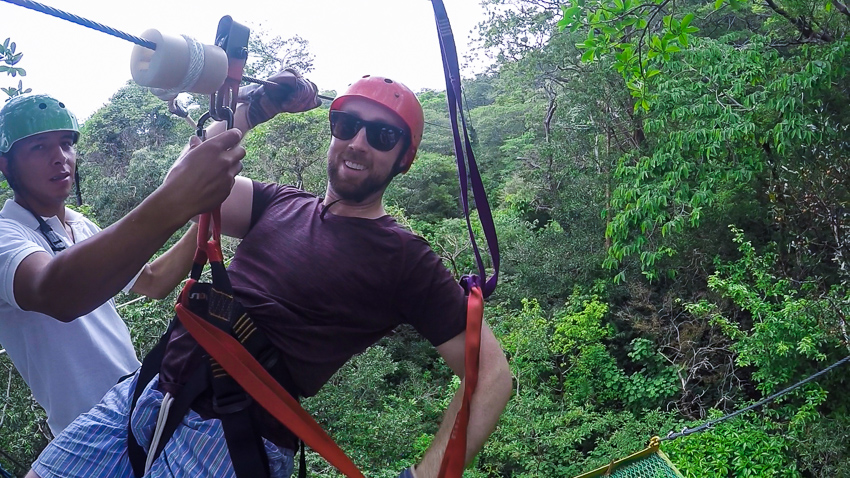
Are Ziplines Safe in Costa Rica?
Yes. The answer to the question of are ziplines safe in Costa Rica? is yes! Although there is no set standard that zipline companies are required to meet in Costa Rica, companies have taken it upon themselves to have high safety standards. Ziplining companies want to ensure that their riders know everything they need and have the proper safety equipment in case something were to happen.
In Costa Rica, the tourism industry is one of their most important industries. For that reason, zipline companies understand they need to have a high review/appraisal rating, or they will not have any visitors. That goes hand-in-hand with safety.
Now, not all zipline companies are the same, and because there are no set standards for each company to follow, we recommend that you do your research. See what TripAdvisor or other review websites say about the company and canopy tour before participating. In our opinion, the larger the company, the more safety precautions they likely have. All of this said we have to remind you that with any kind of adventure tour, there is always a risk, but there are also ways to minimize the risk.
National Standards
Costa Rica has very few national standards or regulations that companies must follow when it comes to adventure tours and ziplining. The zipline tour company is responsible for ensuring they have the highest standards for their guests and proper training for their employees.
With the looming question of “Are ziplines safe in Costa Rica?” larger zipline tour companies have taken it upon themselves to seek professional training when it comes to safety standards. In order to do this, zipline companies have reached out to the American Association for Challenge Course Technology (ACCT). This is the same company that designs and certifies adventure companies in the United States. If you see a certificate that this company or other international companies have certified the zipline tour, you’re likely in good hands!
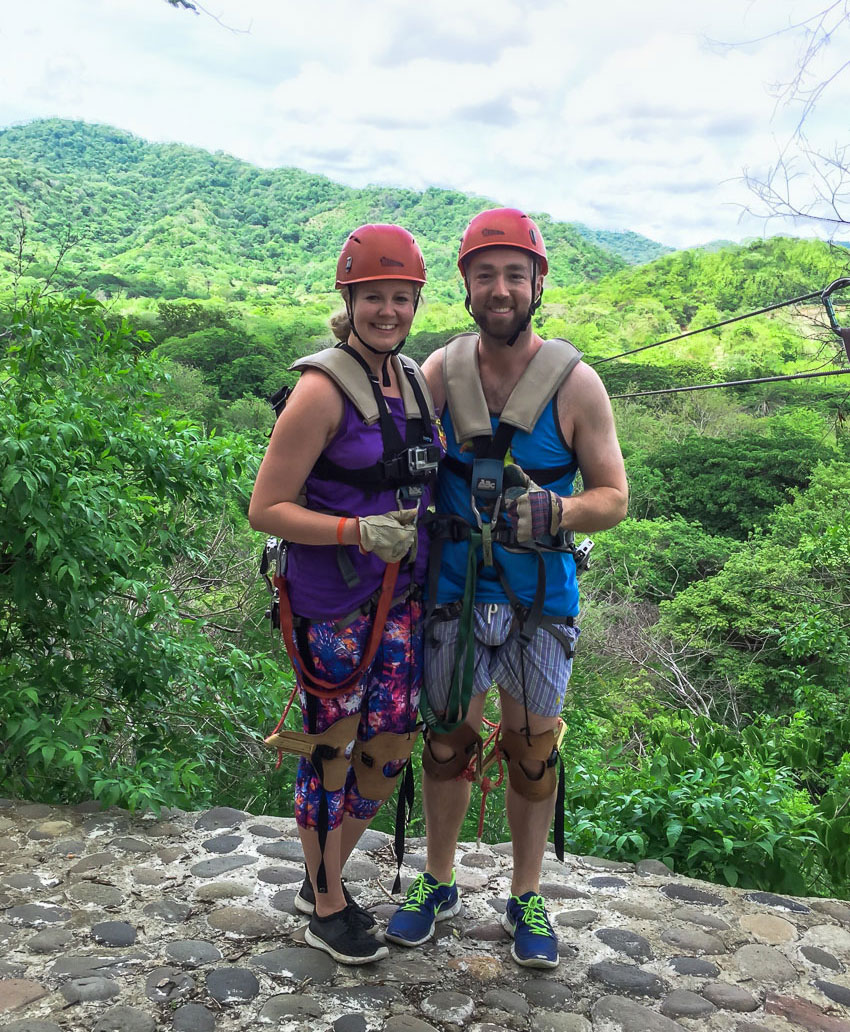
Safety Features to Look For
First and foremost, there needs to be a safety demonstration. We did a couple of canopy tours, and the safety instructions varied drastically. Nonetheless, we felt comfortable with the demonstrations given. Most tours show you how you will be clipped onto the wire and explain every possible situation that might occur.
We also recommend that you make your own visual observations. All equipment should be checked on a daily basis, but sometimes things can slip through the cracks. Make sure that your harness and cables don’t have any cuts or splices or look excessively worn out. Also, look at your trolleys to make sure the wheels spin well and that there’s no rust, bends, or cracks. If you have any concerns don’t be shy – mention it to your guide!
Ziplining Gear You Will Use
Some of the common zipline gear that you will use while ziplining in Costa Rica are:
- The Harness – The most common and comfortable harness is the one that goes around your waist and both your thighs. In the case of the Extreme Canopy Zipline Tour, we had additional harnesses to wear around our chest and knees since we would be soaring on our stomachs to give the illusion of flying!
- Helmet – This will protect your head from hitting branches or the physical zipline wire.
- Trolley – This is the actual device that sits on and secures you to the zipline wire. This will allow you to glide along with ease. There are commonly two trolleys to distribute your weight and act as a backup in case one fails.
- Carabiners – These are not the cheap carabiners you can buy at a Dollar Store. These are heavy-duty carabiners that connect your harness to the trolley via heavy-duty straps.
- Gloves – Depending on the type of braking system the zipline has; the gloves will be reflective of that. They could be basic gardening gloves just to stop skin abrasions or heavy-duty leather gloves with extra padding sewn in, used to brake on the cable.
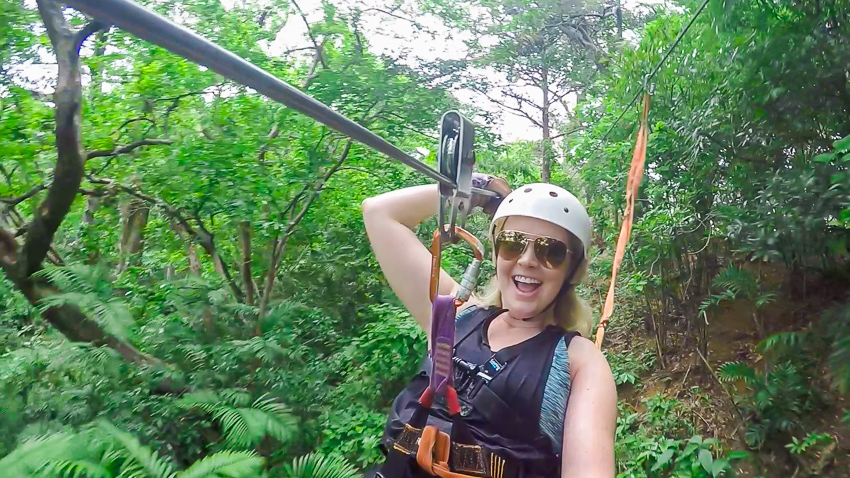
How Scary is Ziplining in Costa Rica?
Once you get the first zipline under your belt, you should feel much better about the course! It is more in the build-up of getting strapped in and hooked up to the zipline that can be “scary”. Even for those afraid of heights, you’d be surprised how thrilling and beautiful it is to soar through the rainforest! Once you sit down to take off, you quickly understand that these lines can hold your weight with no problem, and you will be ready for one of the most adventurous rides of your life!
After a couple of ziplines under your belt, you will likely want more! That’s at least what happened with us, and why we ended up doing a few different courses. At this point, you’ll likely be able to answer the elusive “Are ziplines safe in Costa Rica?” question yourself!
Is There a Weight Limit?
Unfortunately, there sometimes are weight limits, but not for the reason you may think. We have noticed that, on average, most companies impose a weight limit of 250-275 lbs. If you are concerned that the wire might not be able to hold you, don’t be! The wires used on ziplines are specialty wires and can hold thousands of pounds of weight.
The reason for the weight restriction is not because the cable cannot hold the weight. It is based on the speed the rider will or will not be able to obtain and how much of a decline is on the zipline itself. While ziplines often look really fast, you can get stuck in the middle of one. That’s where things can be a bit more challenging! (Don’t worry if it does happen – these companies have experienced every situation imaginable. This is just something we never thought of!)
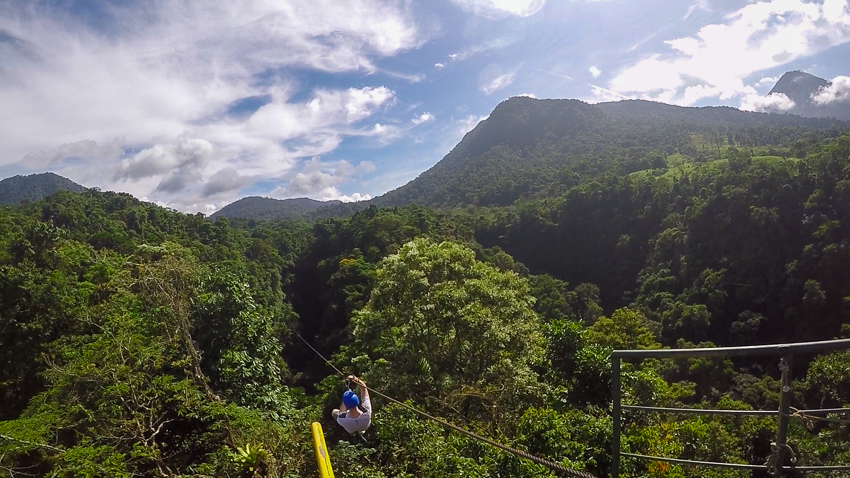
Are There Health Restrictions?
Yes.. and no. The standard medical conditions apply to ziplining. If you have a heart condition, are pregnant, or suffer from a health condition that can be evoked by extreme stress, this might not be the activity for you. Please also note that you may be required to hike to your zipline platforms carrying all the equipment that is attached to you. Your zipline equipment will weigh approximately 10 lbs.
How Old Do You Have to Be?
Although there are no age restrictions for ziplining in Costa Rica, most companies will set their own minimum age restrictions. Those age restrictions vary depending on the company, but the average minimum age is typically 5-7 years old. We recommend checking the website or contacting the company before going if you have a young child.
Ziplining with Kids
So now you’re wondering, are ziplines safe in Costa Rica for kids? Most definitely! Ziplining in Costa Rica is definitely something the whole family can do! Most canopy tours are family-friendly and will have smaller gear for your child(ren). The harness will fit snug just like an adult’s. While up in the canopies and on the platform everyone is always harnessed into the safety guide wire in case someone does slip and fall. Because children are often significantly lighter than full-grown adults, they may be required to go with a guide on some of the ziplines to ensure they get to the other side. The safety precautions taken are the same for everyone on the canopy tour to ensure everybody has a fun and safe time.
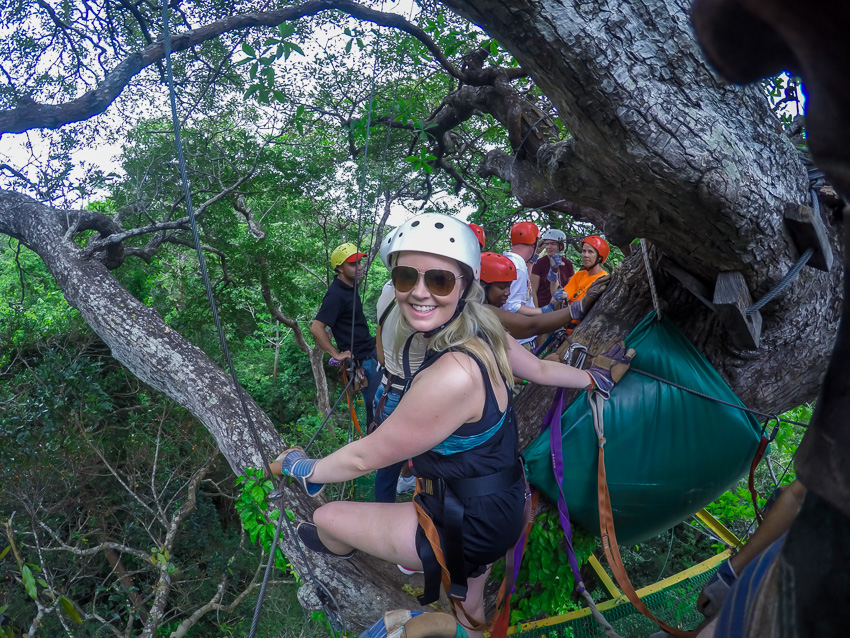
What to Wear Ziplining in Costa Rica?
This was, in fact, a concern for us. We have read many other blogs and articles where people mentioned that you need to wear pants! Sorry – it’s 40 Celsius (104 F) without the humidity, and neither of us wanted to wear long pants.
Don’t worry – you can wear shorts and probably a lot of other things you thought you couldn’t. We’ve summarized everything you need to know about what to wear ziplining in Costa Rica.
How Safe is Traveling in Costa Rica?
We decided to rent a car in Costa Rica to experience as many places as we could. In our opinion, Costa Rica was one of the safest places we have ever travelled to! There was only one point when we felt scared, and that was when we were pulled over to the side of the road to take a photo. A dark SUV pulled up, but it was simply an old man asking if we were having car trouble and if he could help!
Another thing to note is that trucks and transport trucks rule the road. Even if there is a sign or streetlight, be aware of the trucks; they seem to make their own rules sometimes! In some cases, the roads weren’t as developed as they are in some countries, so we had some fun “off-roading,” but their highways are impeccable! We really did have a lot of fun exploring and travelling around Costa Rica!

Is Costa Rica a Dangerous Place to Visit?
No! Costa Rica is not a dangerous place at all. To be honest, we had the same apprehension about going for this exact reason. Once you arrive and begin to speak to the locals, you quickly understand that everyone is extremely friendly and helpful. After the 1948 Civil War in Costa Rica, the Costa Rican President abolished the military. Policing is solely done by the local police force. Today, the entire country has taken on the “Pura Vida” lifestyle, translating to the ‘simple life’. All 5 million Costa Ricans follow this philosophy and treat everyone like family.
Where to Go Ziplining
- Arenal Mundo Aventura – We did the Big AMA course and HIGHLY recommend it! They have a 980-meter cable (over half a mile) that crosses over the La Fortuna Waterfall with the Arenal Volcano in the background.
- Buena Vista Eco Adventure Park – We booked this excursion through our hotel as soon as we got to Costa Rica! It included transportation to Buena Vista Eco Adventure Park, a canopy tour, lunch, horseback riding, hot springs and a natural waterslide (built into the landscape).
- Congo Trail Canopy Tour – We did a packaged ATV & Canopy Tour. We were given the option to do the Extreme Canopy Zipline Tour, and of course, we said yes! At this point, we had already done two canopy tours, so we thought, why not?! This tour allowed us to zipline on our stomachs together, and at the end, there was a Tarzan swing, where you go to choose sitting or going upside down. These ziplines were definitely a bit more Extreme, but totally worth it!
So, are ziplines safe in Costa Rica?
At the end of the day, we certainly answer the question, “Are ziplines safe in Costa Rica?” with a YES! We loved every minute of the canopy tours we went on. Costa Rica is a top adventure destination, especially for those who love soaring hundreds of feet in the air, through the rainforest. It is easy for news reports to feature devastating or controversial news stories; however, at the end of the day, we feel there are things to look for and reputable companies to choose from to ensure your safety.
This post is intended to serve as a guide to Canopy (Zipline) Tours in Costa Rica – to help you choose whether you’d like to go on a tour and, if so, which companies may be best. This post is solely our opinion, and as with any activity, there may be risk involved.


